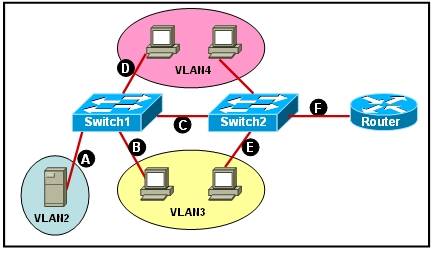CCNA – VLAN Questions
Here you will find answers to VLAN Questions
If you are not sure about VLAN, please read my VLAN tutorial.
Question 1
Refer to the exhibit. A network associate needs to configure the switches and router in the graphic so that the hosts in VLAN3 and VLAN4 can communicate with the enterprise server in VLAN2. Which two Ethernet segments would need to be configured as trunk links? (Choose two)

A. A
B. B
C. C
D. D
E. E
F. F
Answer: C F
Explanation
The link between the switches and the link between switch & router should be configured as trunks. Other links (connected to hosts) should be configured as access links.
Question 2
Which three statements are typical characteristics of VLAN arrangements? (Choose three)
A. A new switch has no VLANs configured.
B. Connectivity between VLANs requires a Layer 3 device.
C. VLANs typically decrease the number of collision domains.
D. Each VLAN uses a separate address space.
E. A switch maintains a separate bridging table for each VLAN.
F. VLANs cannot span multiple switches.
Answer: B D E
Explanation
By default, all ports on a new switch belong to VLAN 1 (default & native VLAN). There are also some well-known VLANs (for example: VLAN 1002 for fddi-default; VLAN 1003 for token-ring…) configured by default -> A is not correct.
To communicate between two different VLANs we need to use a Layer 3 device like router or Layer 3 switch -> B is correct.
VLANs don’t affect the number of collision domains, they are the same -> C is not correct. Typically, VLANs increase the number of broadcast domains.
We must use a different network (or sub-network) for each VLAN. For example we can use 192.168.1.0/24 for VLAN 1, 192.168.2.0/24 for VLAN 2 -> D is correct.
A switch maintains a separate bridging table for each VLAN so that it can send frame to ports on the same VLAN only. For example, if a PC in VLAN 2 sends a frame then the switch look-ups its bridging table and only sends frame out of its ports which belong to VLAN 2 (it also sends this frame on trunk ports) -> E is correct.
We can use multiple switches to expand VLAN -> F is not correct.
Question 3
By default, each port in a Cisco Catalyst switch is assigned to VLAN1. Which two recommendations are key to avoid unauthorized management access? (Choose two)
A. Create an additional ACL to block the access to VLAN 1.
B. Move the management VLAN to something other than default.
C. Move all ports to another VLAN and deactivate the default VLAN.
D. Limit the access in the switch using port security configuration.
E. Use static VLAN in trunks and access ports to restrict connections.
F. Shutdown all unused ports in the Catalyst switch.
Answer: B F
Question 4
Which two benefits are provided by creating VLANs? (Choose two)
A. added security
B. dedicated bandwidth
C. provides segmentation
D. allows switches to route traffic between subinterfaces
E. contains collisions
Answer: A C
Question 5
Which two link protocols are used to carry multiple VLANs over a single link? (Choose two)
A. VTP
B. 802.1q
C. IGP
D. ISL
E. 802.3u
Answer: B D
Explanation
Cisco switches support two trunking protocols 802.1q & ISL. 802.1q is an open standard and is thus compatible between most vendors’ equipment while Inter-Switch Link (ISL) is Cisco proprietary.
Question 6
A switch is configured with all ports assigned to vlan 2 with full duplex FastEthernet to segment existing departmental traffic. What is the effect of adding switch ports to a new VLAN on the switch?
A. More collision domains will be created.
B. IP address utilization will be more efficient.
C. More bandwidth will be required than was needed previously.
D. An additional broadcast domain will be created.
Answer: D
Question 7
Which two statements about the use of VLANs to segment a network are true? (Choose two)
A. VLANs increase the size of collision domains.
B. VLANs allow logical grouping of users by function.
C. VLANs simplify switch administration.
D. VLANs enhance network security.
Answer: B D
Question 8
Cisco Catalyst switches CAT1 and CAT2 have a connection between them using ports Fa0/13. An 802.1Q trunk is configured between the two switches. On CAT1, VLAN 10 is chosen as native, but on CAT2 the native VLAN is not specified. What will happen in this scenario?
A. 802.1Q giants frames could saturate the link.
B. VLAN 10 on CAT1 and VLAN 1 on CAT2 will send untagged frames.
C. A native VLAN mismatch error message will appear.
D. VLAN 10 on CAT1 and VLAN 1 on CAT2 will send tagged frames.
Answer: C
Explanation
A “native VLAN mismatch” error will appear by CDP if there is a native VLAN mismatch on an 802.1Q link. “VLAN mismatch” can cause traffic from one vlan to leak into another vlan.
Question 9
Which two statements describe the Cisco implementation of VLANs? (Choose two)
A. VLAN 1 is the default Ethernet VLAN.
B. CDP advertisements are only sent on VLAN 1002.
C. By default, the management VLAN is VLAN 1005.
D. By default, the switch IP address is in VLAN 1005.
E. VLANs 1002 through 1005 are automatically created and cannot be deleted.
Answer: A E
Question 10
What are three advantages of VLANs? (Choose three)
A. VLANs establish broadcast domains in switched networks.
B. VLANs utilize packet filtering to enhance network security.
C. VLANs provide a method of conserving IP addresses in large networks.
D. VLANs provide a low-latency internetworking alternative to routed networks.
E. VLANs allow access to network services based on department, not physical location.
F. VLANs can greatly simplify adding, moving, or changing hosts on the network.
Answer: A E F



anyone has some dumps please im gonna exam next weeks thank you in advance. {email not allowed}